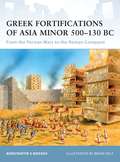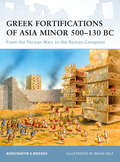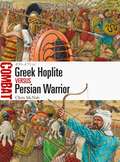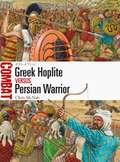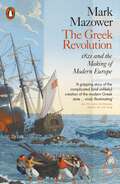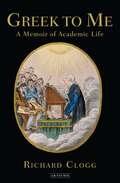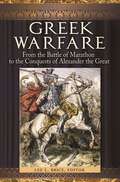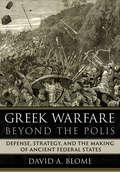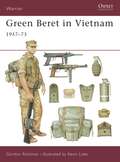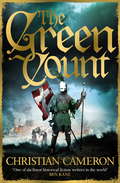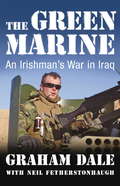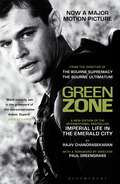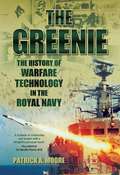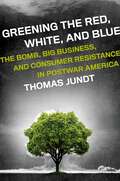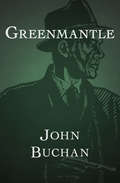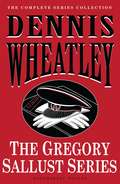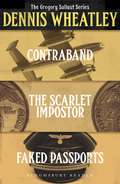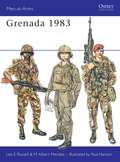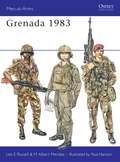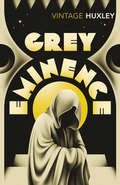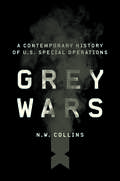- Table View
- List View
Greek Fortifications of Asia Minor 500–130 BC: From the Persian Wars to the Roman Conquest (Fortress)
by Konstantin Nossov Brian DelfSandwiched between the heart of ancient Greece and the lands of Persia, the Greek cities of Western Anatolia were the spark that ignited some of the most iconic conflicts of the ancient world. Fought over repeatedly in the 5th century BC, their conquest by the Persians provided a casus belli for Alexander the Great to cross the Hellespont in 334 BC and launch the battle of Granicus and the sieges of Miletus and Halicarnassus. A blend of Greek and Asian styles of military architecture, these fortified cities were revolutionary in their multi-linear construction – successive defensive walls – with loopholes and mural arches. Konstantin Nossov illustrates the evolution of Greek fortifications and the influences of the region they bordered in this fascinating study.
Greek Fortifications of Asia Minor 500–130 BC: From the Persian Wars to the Roman Conquest (Fortress #90)
by Konstantin Nossov Konstantin S NossovSandwiched between the heart of ancient Greece and the lands of Persia, the Greek cities of Western Anatolia were the spark that ignited some of the most iconic conflicts of the ancient world. Fought over repeatedly in the 5th century BC, their conquest by the Persians provided a casus belli for Alexander the Great to cross the Hellespont in 334 BC and launch the battle of Granicus and the sieges of Miletus and Halicarnassus. A blend of Greek and Asian styles of military architecture, these fortified cities were revolutionary in their multi-linear construction – successive defensive walls – with loopholes and mural arches. Konstantin Nossov illustrates the evolution of Greek fortifications and the influences of the region they bordered in this fascinating study.
Greek Hoplite vs Persian Warrior: 499–479 BC (Combat #31)
by Adam Hook Chris McNabThe Greco-Persian Wars (499–449 BCE) convulsed Greece, Asia Minor and the Near East for half a century. Through a series of bloody invasions and pitched battles, the mighty Persian Empire pitted itself against the smaller armies of the Greeks, strengthened through strategic alliances. This epic conflict also brought together two different styles of warfare: the Greek hoplite phalanx and the combined spear and projectile weapon-armed Persian infantry. Analysing the battles of Marathon, Thermopylae and Plataea from the eyes of a soldier, this study explores the experience of front-line combat during the first two decades of the Greco-Persian Wars. Fully illustrated with modern photographs and archival images, and drawing directly on primary sources and the most authoritative recent research, this is the enthralling story of the fighting men of Greece and Persia and the tactics and technologies they employed.
Greek Hoplite vs Persian Warrior: 499–479 BC (Combat #31)
by Chris McNab Mr Adam HookThe Greco-Persian Wars (499–449 BCE) convulsed Greece, Asia Minor and the Near East for half a century. Through a series of bloody invasions and pitched battles, the mighty Persian Empire pitted itself against the smaller armies of the Greeks, strengthened through strategic alliances. This epic conflict also brought together two different styles of warfare: the Greek hoplite phalanx and the combined spear and projectile weapon-armed Persian infantry. Analysing the battles of Marathon, Thermopylae and Plataea from the eyes of a soldier, this study explores the experience of front-line combat during the first two decades of the Greco-Persian Wars. Fully illustrated with modern photographs and archival images, and drawing directly on primary sources and the most authoritative recent research, this is the enthralling story of the fighting men of Greece and Persia and the tactics and technologies they employed.
The Greek Revolution: 1821 and the Making of Modern Europe
by Mark Mazower'Exquisite, impressive' Gerard DeGroot, The Times'Superbly subtle and thorough' Julian Evans, Daily Telegraph'Fast-flowing narrative and insightful analysis' Tony Barber, Financial TimesA thrilling history of the revolutionary birth of modern Greece from 'the preeminent historian of a generation' (Misha Glenny)In the exhausted, repressive years that followed Napoleon's defeat in 1815, there was one cause that came to galvanize countless individuals across Europe and the United States: freedom for Greece.Mark Mazower's wonderful new book recreates one of the most compelling, unlikely and significant events in the story of modern Europe. In the face of near impossible odds, the people of the villages, valleys and islands of Greece rose up against Sultan Mahmud II and took on the might of the imperial Ottoman armed forces, its Turkish cavalrymen, Albanian foot soldiers and the fearsome Egyptians. Despite the most terrible disasters, they held on until military intervention by Russia, France and Britain finally secured the kingdom of Greece.Mazower brilliantly brings together the different strands of the story. He takes us into the minds of revolutionary conspirators and the terrors of besieged towns, the stories of itinerant priests, sailors and slaves, ambiguous heroes and defenceless women and children struggling to stay alive amid a conflict of extraordinary brutality. Ranging across the Eastern Mediterranean and far beyond, he explores the central place of the struggle in the making of Romanticism and a new kind of politics that had volunteers flocking from across Europe to die in support of the Greeks. A story of how statesmen came to terms with an even more powerful force than themselves - the force of nationalism - this is above all a book about how people decided to see their world differently and, at an often terrible cost to themselves and their families, changed history.
Greek to Me: A Memoir of Academic Life
by Richard CloggThe 1960s were a tumultuous period in the history of Greece, as its democracy fell under the forced establishment of a military dictatorship. The regime of the Colonels was the culmination of national division and hostility between communist forces and right wing militants. It was in these extraordinary times that British historian Richard Clogg witnessed the 1967 coup, while living in Athens and researching modern Greek history. Following his abrupt immersion in Greek politics and political activism, Clogg went on to a joint appointment at the School of Slavonic and East European Studies (SSEES) and King's College, London. At SSEES, he uncovered the contested history of nationalist funding in academia and postings. After publishing his controversial book Politics and the Academy, Clogg moved to St Antony's College, Oxford. Greek to Me: A Memoir of Academic Life is an engrossing tale of academic and political intrigue, spanning Clogg's time in Greece and in the Department of Byzantine and Modern Greek Studies at King's College London. Through extensive personal archives of his fascinating adventures, Clogg exposes the secretive fields of academia and university politics as well as providing unique eyewitness accounts of modern Greek history.
Greek Warfare: From the Battle of Marathon to the Conquests of Alexander the Great
by Lee L. BriceThis book brings together reference material and primary source documents concerning the most important people, places, events, and technologies of Classical Greek warfare in one easy-to-use volume—an invaluable resource for students, educators, and general readers interested in this compelling subject. Greek Warfare: From the Battle of Marathon to the Conquests of Alexander the Great is a unique reference book that examines warfare in ancient Greece during the Classical era between 490 and 323 BCE. This easy-to-use, multi-format handbook provides a range of tools for investigating the military history of Classical Greece, including a timeline, reference entries, selected primary source documents, charts, and a glossary. The accessible reference entries illuminate all of the most important topics and issues within Classical Greek warfare, while the book's logical organization allows students, educators, and general readers alike to quickly find the specific information they seek. The comprehensive bibliography serves as a perfect gateway to additional resources on the subject.
Greek Warfare: From the Battle of Marathon to the Conquests of Alexander the Great
by Lee L. BriceThis book brings together reference material and primary source documents concerning the most important people, places, events, and technologies of Classical Greek warfare in one easy-to-use volume—an invaluable resource for students, educators, and general readers interested in this compelling subject. Greek Warfare: From the Battle of Marathon to the Conquests of Alexander the Great is a unique reference book that examines warfare in ancient Greece during the Classical era between 490 and 323 BCE. This easy-to-use, multi-format handbook provides a range of tools for investigating the military history of Classical Greece, including a timeline, reference entries, selected primary source documents, charts, and a glossary. The accessible reference entries illuminate all of the most important topics and issues within Classical Greek warfare, while the book's logical organization allows students, educators, and general readers alike to quickly find the specific information they seek. The comprehensive bibliography serves as a perfect gateway to additional resources on the subject.
Greek Warfare beyond the Polis: Defense, Strategy, and the Making of Ancient Federal States
by David A. BlomeGreek Warfare beyond the Polis assesses the nature and broader significance of warfare in the mountains of classical Greece. Based on detailed reconstructions of four unconventional military encounters, David A. Blome argues that the upland Greeks of the classical mainland developed defensive strategies to guard against external aggression. These strategies enabled wide-scale, sophisticated actions in response to invasions, but they did not require the direction of a central, federal government. Blome brings these strategies to the forefront by driving ancient Greek military history and ancient Greek scholarship "beyond the polis" into dialogue with each other. As he contends, beyond-the-polis scholarship has done much to expand and refine our understanding of the ancient Greek world, but it has overemphasized the importance of political institutions in emergent federal states and has yet to treat warfare involving upland Greeks systematically or in depth. In contrast, Greek Warfare beyond the Polis scrutinizes the sociopolitical roots of warfare from beyond the polis, which are often neglected in military histories of the Greek city-state.By focusing on the significance of warfare vis-à-vis the sociopolitical development of upland polities, Blome shows that although the more powerful states of the classical Greek world were dismissive or ignorant of the military capabilities of upland Greeks, the reverse was not the case. The Phocians, Aetolians, Acarnanians, and Arcadians in circa 490–362 BCE were well aware of the arrogant attitudes of their aggressive neighbors, and as highly efficient political entities, they exploited these attitudes to great effect.
Green Beret in Vietnam: 1957–73 (Warrior)
by Gordon L. Rottman Kevin LylesVietnam was the US Special Forces most complex and controversial mission, one that began in 1957 and ended in 1973. Camp strike forces, mobile strike forces, mobile guerrilla forces, special reconnaissance projects, training missions and headquarters duty provided vastly differing experiences and circumstances for SF soldiers. Other fluctuating factors were the terrain, the weather and the shifting course of the war itself. Gordon Rottman examines the training, life, weapons and combat experiences of the Special Forces soldier in this challenging environment.
Green Beret in Vietnam: 1957–73 (Warrior #28)
by Gordon L. Rottman Kevin LylesVietnam was the US Special Forces most complex and controversial mission, one that began in 1957 and ended in 1973. Camp strike forces, mobile strike forces, mobile guerrilla forces, special reconnaissance projects, training missions and headquarters duty provided vastly differing experiences and circumstances for SF soldiers. Other fluctuating factors were the terrain, the weather and the shifting course of the war itself. Gordon Rottman examines the training, life, weapons and combat experiences of the Special Forces soldier in this challenging environment.
The Green Count (Chivalry)
by Christian CameronOne of the finest historical fiction writers in the world - Ben KaneAfter the bloody trials of Alexandria, Sir William Gold is readying for a pilgrimage to Jerusalem to ease the burden on his soul. He hopes, too, that the Holy City might allow his relationship with Emile, cousin of the Green Count of Savoy, to develop.But the Roman Emperor of Constantinople has been taken hostage by an unknown enemy, and the Green Count is vital to the rescue effort. It is up to Sir William to secure his support, but he soon finds that his past, and his relationship with Emile, might have repercussions he had not foreseen...Suddenly thrust onto the stage of international politics, Sir William finds himself tangled in a web of plots, intrigue and murder. He must hold true to his chivalric principles, and to his knights, if he is to save the Emperor and survive to tell the tale.
The Green Marine: An Irishman's War in Iraq
by Neil Fetherstonhaugh Graham DaleDubliner Graham Dale, an IT specialist living in Texas, was working as a volunteer with a fire department when he heard that an airplane had hit the World Trade Centre in New York. As the tragic events unfolded before his eyes, he suddenly realised that he could no longer remain a spectator in the face of this appalling atrocity. There and then he made a decision that was to affect the rest of his life; he drove to the nearest Military Recruitment Centre and enlisted in the US Marines.After surviving months of 'constant mental and physical torture' in the notoriously tough 'Marine Boot Camp' in San Diego, he joined the ranks of one of the most elite branches of the United States military and two years later found himself patrolling the dangerous wastes of the western desert in war-torn Iraq. Throughout his deployment in Iraq, Dale kept a daily journal to give us an astonishing, true account of one man's fight in the frontline of America's 'War on Terror'. Told with brutal honesty, he gives us a unique and rare insight from an Irishman, fighting for a foreign military in a very foreign land.
Green Zone: Imperial Life in the Emerald City
by Rajiv ChandrasekaranFrom inside a surreal bubble of pure Americana known as the Green Zone, the US-led Coalition Provisional Authority attempted to rule Iraq following the fall of Saddam Hussein's regime. Drawing on interviews and internal documents, Rajiv Chandrasekaran tells the memorable story of this ill-prepared attempt to build American democracy in a war-torn Middle Eastern country, detailing not only the risky disbanding of the Iraqi army and the ludicrous attempt to train the new police force, but absurdities such as the aide who based Baghdad's new traffic laws on those of the state of Maryland, downloaded from the net, and the twenty-four-year-old who had never worked in finance put in charge of revitalising Baghdad's stock exchange. Imperial Life in the Emerald City is American reportage at its best.
The Greenie: The History of Warfare Technology in the Royal Navy
by Patrick A MooreIn the Royal Navy vernacular, the term 'greenie' describes the officers and ratings responsible for the electrical engineering functions of the fleet. Electrical engineering has 'driven' the Royal Navy for far longer than one might imagine, from solving the problem of magnetic interference with the compass by the ironclad early in the 20th century onward. Author Commander Moore traces the development of technology from 1850 to today's integrated micro computers that control almost every aspect of navigation, intel, and strike capacity. At the same time, he describes how the Navy's structure and manpower changed to accommodate the new technologies, changes often accelerated in wartime, particularly in World War II. Without the full cooperation of naval establishments and organisations and various public and private museums and manufacturers, this work would have been impossible to produce. Written in an anecdotal, narrative style but with a complete mastery of the science itself, it will appeal not only to those interested in the history of the Royal Navy but also those many thousands, past and present, who can claim the honour of calling themselves one of the Greenies. Commander Patrick A Moore joined the Royal Navy in 1963 and graduated with a BSc in Electrical Engineering before going to sea as a Weapons Engineer Officer on HMS Ajax. He later served as Squadron Weapons Officer during the First Gulf War. After leaving the Service in 1992, he worked for Ferranti International and GEC, focussing on warship combat system simulators. His involvement with ops, R&D, shipbuilding and training functions of the Royal Navy therefore spans an impressive 42 years. No one else is qualified to tell this story.
Greening the Red, White, and Blue: The Bomb, Big Business, and Consumer Resistance in Postwar America
by Thomas JundtIn popular imagination, environmentalism is often linked to Rachel Carson's Silent Spring and the political activism of the 1960s and '70s that moved increasing numbers of Americans to insist on a better quality of life-open spaces, clean air and water, beautification campaigns. But these interpretations have obscured the significant origins of environmentalism as a moral and intellectual broadside against the growing power of corporate capitalism, both domestically and in the postwar liberal international order the United States was enacting abroad. In Greening the Red, White, and Blue, Thomas Jundt shows how many Americans came to view powerful corporations and a federal government bent on economic growth as threats to human health and the environment. Fallout from atomic testing, air and water pollution, the proliferation of pesticides and herbicides-all connected to the growing dominance of technology and corporate capitalism in American life-led a variety of constituencies to seek solutions in what came to be known as environmentalism. In addition to political and legal campaigns to effect change, an alternative form of civic participation emerged beginning in the late-1940s as growing numbers of citizens turned to what they deemed environmentally friendly consumption practices. The goal of this politically charged consumption was not only to protect themselves and their families from harm, but also to achieve social change at a time when many believed the government was placing the desires of business before the needs of its citizens. Politicians responded to the growing environmental concerns of middle class Americans, but, in the end, continual political compromises with corporate power meant weak laws and lax enforcement. Many citizens sought refuge in an alternative "green" marketplace-including organic foods, natural-fiber clothing, alternative energy, and everyday products designed to have minimal environmental impact. In doing so, they attempted to create a community for those who shared their concerns and frustrations, as well as their vision for a different American Way. Thomas Jundt's work highlights the intertwining of consumerism and environmentalism amidst the growing power of corporate capitalism and government in postwar America.
Greening the Red, White, and Blue: The Bomb, Big Business, and Consumer Resistance in Postwar America
by Thomas JundtIn popular imagination, environmentalism is often linked to Rachel Carson's Silent Spring and the political activism of the 1960s and '70s that moved increasing numbers of Americans to insist on a better quality of life-open spaces, clean air and water, beautification campaigns. But these interpretations have obscured the significant origins of environmentalism as a moral and intellectual broadside against the growing power of corporate capitalism, both domestically and in the postwar liberal international order the United States was enacting abroad. In Greening the Red, White, and Blue, Thomas Jundt shows how many Americans came to view powerful corporations and a federal government bent on economic growth as threats to human health and the environment. Fallout from atomic testing, air and water pollution, the proliferation of pesticides and herbicides-all connected to the growing dominance of technology and corporate capitalism in American life-led a variety of constituencies to seek solutions in what came to be known as environmentalism. In addition to political and legal campaigns to effect change, an alternative form of civic participation emerged beginning in the late-1940s as growing numbers of citizens turned to what they deemed environmentally friendly consumption practices. The goal of this politically charged consumption was not only to protect themselves and their families from harm, but also to achieve social change at a time when many believed the government was placing the desires of business before the needs of its citizens. Politicians responded to the growing environmental concerns of middle class Americans, but, in the end, continual political compromises with corporate power meant weak laws and lax enforcement. Many citizens sought refuge in an alternative "green" marketplace-including organic foods, natural-fiber clothing, alternative energy, and everyday products designed to have minimal environmental impact. In doing so, they attempted to create a community for those who shared their concerns and frustrations, as well as their vision for a different American Way. Thomas Jundt's work highlights the intertwining of consumerism and environmentalism amidst the growing power of corporate capitalism and government in postwar America.
Greenmantle
by John BuchanThe second installment in the electrifying adventures of Richard Hannay, Britain’s greatest secret agentMajor Richard Hannay, hero of The Thirty-Nine Steps, is recovering from wounds sustained in the bloody Battle of Loos when his old friend Sir Walter Bullivant summons him to the Foreign Office. Hoping for a promotion, Hannay is asked instead to investigate rumors that a “star rising in the West” is about to bring the entirety of the Muslim world under the Kaiser’s control. Hannay enlists the help of a polyglot British soldier and a dyspeptic American spy to go undercover first in Germany and then in Constantinople, where the glamorous and enigmatic Hilda von Einem is behind the conspiracy. In a stunning climax set during the pivotal clash between Russian and Ottoman forces over the Turkish city of Erzerum, Hannay and his cohorts risk everything to ensure that England and her allies will live to fight another day.With its skillful blend of political insight and heart-stopping action, Greenmantle was a huge step forward in the development of the modern espionage novel. It was also, and still very much is, an irresistible thrill ride from first page to last.This ebook has been professionally proofread to ensure accuracy and readability on all devices.
The Gregory Sallust Series (Gregory Sallust Ser.)
by Dennis Wheatley'Before there was James Bond, there was Gregory Sallust.' Tina Rosenberg, Salon.comDennis Wheatley's complete, bestselling Gregory Sallust series featuring the debonair spy Gregory Sallust, a forerunner to Ian Fleming's James Bond. During WWII, Dennis Wheatley was hired by Winston Churchill to be a part of a highly confidential group of strategists. He was one of the only civilians to be recruited, on the strength that he had shown a flair for deception and cover stories in his novels, particularly through his incarnation of Gregory Sallust - widely regarded as the inspiration for Ian Fleming's James Bond. This complete collection includes the following titles in chronological order of events as they occur within the novels: CONTRABANDTHE SCARLET IMPOSTORFAKED PASSPORTTHE BLACK BARONESSV FOR VENGEANCECOME INTO MY PARLOURTRAITORS' GATETHEY USED DARK FORCESTHE ISLAND WHERE TIME STANDS STILLBLACK AUGUSTTHE WHITE WITCH OF THE SOUTH SEAS
The Gregory Sallust Series (Gregory Sallust Ser.)
by Dennis WheatleyDennis Wheatley (1897 – 1977) was an English author whose prolific output of stylish thrillers and occult novels made him one of the world's best-selling writers from the 1930s through the 1960s.Wheatley was the eldest of three children, and his parents were the owners of Wheatley & Son of Mayfair, a wine business. He admitted to little aptitude for schooling, and was expelled from Dulwich College, London. In 1919 he assumed management of the family wine business but in 1931, after a decline in business due to the Depression, he began writing.His first book, The Forbidden Territory, became a bestseller overnight, and since then his books have sold over 50 million copies worldwide. During the 1960s, his publishers sold one million copies of Wheatley titles per year, and his Gregory Sallust series was one of the main inspirations for Ian Fleming's James Bond stories.During the Second World War, Wheatley was a member of the London Controlling Section, which secretly coordinated strategic military deception and cover plans. His literary talents gained him employment with planning staffs for the War Office. He wrote numerous papers for the War Office, including suggestions for dealing with a German invasion of Britain.Dennis Wheatley died on 11th November 1977. During his life he wrote over 70 books and sold over 50 million copies.
Grenada 1983 (Men-at-Arms)
by Paul Hannon Lee E RussellOn 21 October 1983, following the death of Prime Minister Maurice Bishop, the leaders of the six small nations forming the Organization of Eastern Caribbean States voted to intervene militarily to restore order in Grenada. As none possessed the forces necessary to carry out a successful operation, the United States, fearing for its citizens on the island, and wanting to curb Cuba's growing influence, decided to get involved. This book provides a day-by-day account of the US invasion of Grenada, focusing on the units and forces deployed. Numerous contemporary photographs and colour plates detail the uniforms and equipment of the US, Cuban and Caribbean forces.
Grenada 1983 (Men-at-Arms #159)
by Paul Hannon Lee E RussellOn 21 October 1983, following the death of Prime Minister Maurice Bishop, the leaders of the six small nations forming the Organization of Eastern Caribbean States voted to intervene militarily to restore order in Grenada. As none possessed the forces necessary to carry out a successful operation, the United States, fearing for its citizens on the island, and wanting to curb Cuba's growing influence, decided to get involved. This book provides a day-by-day account of the US invasion of Grenada, focusing on the units and forces deployed. Numerous contemporary photographs and colour plates detail the uniforms and equipment of the US, Cuban and Caribbean forces.
Grey Eminence: A Study In Religion And Politics
by Aldous Huxley David BradshawThe life of Father Joseph, Cardinal Richelieu's aide, was a shocking paradox. After spending his days directing operations on the battlefield, Father Joseph would pass the night in prayer, or in composing spiritual guidance for the nuns in his care. He was an aspirant to sainthood and a practising mystic, yet his ruthless exercise of power succeeded in prolonging the unspeakable horrors of the Thirty Years War. In his masterful biography, Huxley explores how an intensely religious man could lead such a life and how he could reconcile the seemingly opposing moral systems of religion and politics.
Grey Wars: A Contemporary History of U.S. Special Operations
by N. W. CollinsAn analysis of U.S. Special Operations, at the center of America’s twenty-first-century wars This original and accessible book is a comprehensive, authoritative analysis of U.S. Special Operations. U.S. Special Operations Command trains and equips units to undertake select military activities, frequently high-risk missions, often for the purposes of counterterrorism and counterinsurgency. Since 9/11, impelled by an attack on U.S. soil, these forces have been a central instrument of America’s military campaign—operating in about one hundred countries on any given day. This fight—neither hot war nor cold peace—was launched and executed as a new type of global war in 2001 and has since splintered into a spectrum of regional conflicts. The result is our nation’s grey wars: hazy and lethal. This contemporary history, incorporating extensive interviews and archival research by security studies expert N. W. Collins, delves deeply into the transformation of these forces since 9/11.
